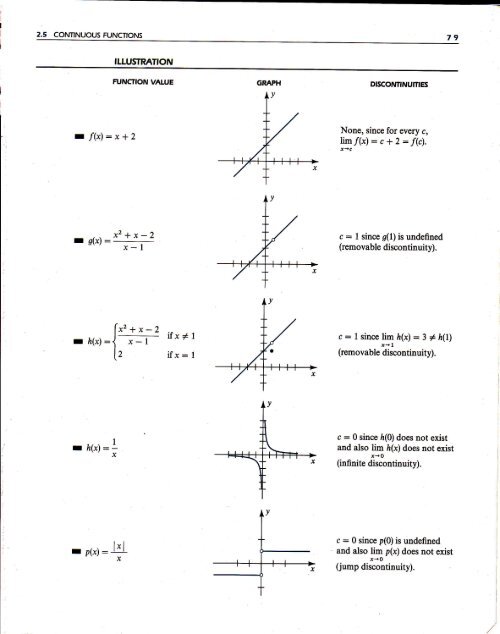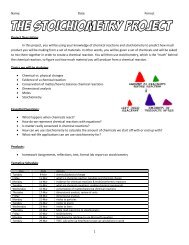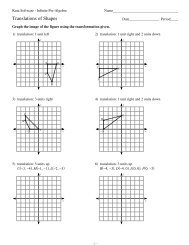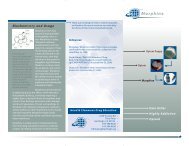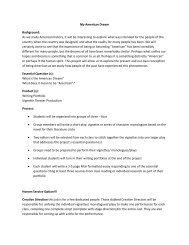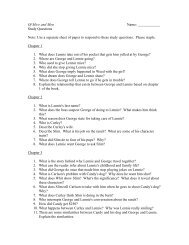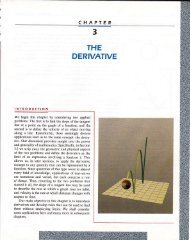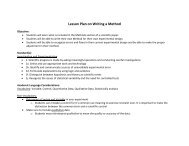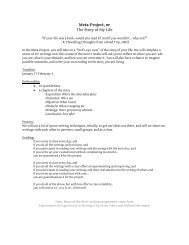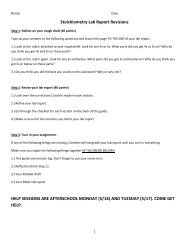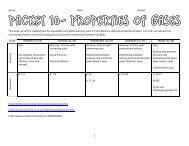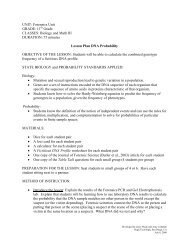Continuous functions notes
Continuous functions notes
Continuous functions notes
You also want an ePaper? Increase the reach of your titles
YUMPU automatically turns print PDFs into web optimized ePapers that Google loves.
2.5 CONTINUOUSFUNCTIONS<br />
79<br />
ILLUSTNANON<br />
FUNCTION VALUE<br />
GRAPH<br />
DISCONTINUITIES<br />
: f(x):x*2<br />
None, since for every c,<br />
lim/(x):c*2:f(c).<br />
r+c<br />
x2+x-2<br />
glx) : ----<br />
.<br />
x-l<br />
c: 1 since 9(1) is undefined<br />
(removable discontinuity).<br />
(.2.ru-)<br />
l* '^ ' rIx*l<br />
r ft(x):i x-1<br />
[z ifx:l<br />
c : 1 since lim tr(x) :3 + h(l)<br />
r+1<br />
(removable discontinuity).<br />
h$):L x<br />
L4<br />
c : 0 since h(0) does not exist<br />
and also lim h(x) does not exist<br />
r+0<br />
(infinite discontinuity).<br />
r p(x):<br />
x<br />
c : 0 since p(0) is undefined<br />
and also lim p(x) does not exist<br />
r+0<br />
(jump discontinuity).<br />
l<br />
)
80 CHAPTER 2 LIMITS OF FUNCTIONS<br />
The next theorem states that polynomial <strong>functions</strong> and rational <strong>functions</strong><br />
(quotients of polynomial <strong>functions</strong>) are continuous at every number<br />
in their domains.<br />
Theorem l2.2ll<br />
,'.tll<br />
lill<br />
A,,OOliromial function,f.,is,r,continuou1l allbvery rea! numbe-r. c,,<br />
,<br />
;,{ raiiod functio*,,4 *,r#p,,is.oontinuousni.Avery number except,<br />
pROOF (i) If/ is a polynomial function and c is a real number, then, by<br />
Theorem (2.11), lim"-"f(x):/(c). Hence / is continuous at every real<br />
number.<br />
(ii) If g(c) # 0, then c is in the domain of q: f lg and, by Theorem<br />
(2.12),lim"-" q(x) : q(c); that is, q is continuous at c. t<br />
EXAMPLE I<br />
number c.<br />
If f(x): lxl, show that f is continuous at every real<br />
FIGURE 2:36<br />
/(,'): l"l<br />
SOLUTION The graph of / is sketched in Figure 2.36. lf x > 0, then<br />
f(x): x. If x < 0, then f(*): -x. Since x and -x are polynomials, it<br />
follows from Theorem (2.21)(i) that / is continuous at every nonzero real<br />
number. It remains to be shown that / is continuous at 0. The one-sided<br />
limits of /(x) at 0 are<br />
lim lxl: lim x:0<br />
x-O + x+O +<br />
and r'y l'1: (-x):0.<br />
"t11r_<br />
Since the right-hand and left-hand limits are equal, it follows from Theorem<br />
(2.3) that<br />
trlqlxl:o:lol:ftol.<br />
Hence / is continuous at 0.<br />
EXAMPLE 2<br />
-2-t<br />
rf f(xl: ?;?=,<br />
find the discontinuities of /.<br />
SOLUTION Since / is a rational function, it follows from Theorem<br />
(2.21) that the only discontinuities occur at the zeros of the denominator<br />
x3 * x2<br />
- 2x.By factoring we obtain<br />
x3 + x2 - 2x : x(x2 + x - 2): x(x f 2)(x - l).<br />
Setting each factor equal to zero, we see that the discontinuities of/ are<br />
at0, -2, and 1.
2.s coNTtNuousFUNcnoNs 8t<br />
If a function / is continuous at every number in an open interval (a, b),<br />
we say that f is continuous on the interval (a, D). Similarly,afunction is<br />
continuous on an infinite interval of the form (a, a) or (_ oo, b) if it is<br />
continuous at every number in the interval. The next definition covers the<br />
case of a closed interval.<br />
Definition 12.221<br />
.rtr!*!1.*& .ba;. .s.ftne ,i closed''inter,val [4,b]- ?he funetion<br />
:'..l'i$,. nuousrdi:l*;,.bliy.iiiccontieuo$s,oa{a; }jandif, in addition,<br />
.: : ..,:.:...:,::..,::tt:,::.:..:,:*tAi:.....,.: : 5+X*. ;). l:. "'<br />
,.<br />
If a function / has either a right-hand or a left-hand limit of the rype<br />
indicated in Definition (2.22), we say that / is continuous from the right<br />
at a or that f is continuous from the left at b, respectively.<br />
EXAMPLE 3 If /(x) : Jg - 7, sketch the graph of / and prove that<br />
/ is continuous on the closed interval [-3, 3].<br />
FIGURE 2.37<br />
SOLUTION The graph of x2 + !2 : 9 is a circle with center at the origin<br />
and radius 3. Solving for y gives us y : +.r,8 -7 , and hence the graph<br />
of y : \E -7 is the upper half of that circle (see Figure 2.37).<br />
If -3 < c < 3, then, using Theorem (2.14), we obtain<br />
rim/k): l'yl,6<br />
+ :.rE -e : f@.<br />
Hence/ is continuous at c by Definition (2.20). Altthat remains is to check<br />
the endpoints of the interval [-3,3] using one-sided limits as follows:<br />
lim /(x): Iim<br />
x-_3+<br />
Vj9-x2:fT-g:0:/(_3)<br />
x__3+ '<br />
IiT f$) : lim uD - xt : 1E=: 0 :<br />
x+3- x+3-<br />
/(3)<br />
3 and from the left at 3. By Def-<br />
Thus, / is continuous from the right at -<br />
inition (2.22), f is continuous on [-3, 3].<br />
Strictly speaking, the function / in Example 3 is discontinuous at every<br />
number c outside of the interv al l-3,3], because /(c) is not a real number<br />
if x < -3 or x > 3. However, itis noi customary to use the phrase discontinuous<br />
at c If c is in an open interval throughout which / is undefined.<br />
we may also define continuity on other types of intervals. For example,<br />
a function / is continuous on fa,b) or la, oo) if it is continuous at<br />
every number greater than a in the interval and if, in addition, / is continuous<br />
from the right at a. For intervals of the form (a,blor (_a,b),<br />
we require continuity at every number less than b in the intirval and also<br />
continuity from the left at b.<br />
Using facts stated in Theorem (2.8), we can proye the following.
7.<br />
82 CHAPTER 2 LIMITS OF FUNCNONS<br />
Theorem {.2.231<br />
PROOF If / and g are continuous at c, then<br />
hm f(x): f(c) and lim s(x) : sk).<br />
By the definition of the sum of two <strong>functions</strong>,<br />
Consequently,<br />
ff + d@\: f(*) + s@).<br />
lim (/ + dU): lim [/(x) +<br />
x+c<br />
s(x)]<br />
: iirft'l + lim s(x)<br />
: J'@) + s@)<br />
: (f + s)(c).<br />
This proves lhat f * g is continuous at c. Parts (ii)-(iv) are proved in<br />
similar fashion. r<br />
If/ and g are continuous on an interval, then/ * g, f - g,and fg are<br />
continuous on the interval. If, in addition, g(c) # 0 for every c in the interval,<br />
then f lg is continuous on the interval. These results may be extended<br />
to more than two <strong>functions</strong>; that is, sums, differences, products, or<br />
quotients involving any number of continuous <strong>functions</strong> are continuous<br />
(provided zero denominators do not occur).<br />
EXAMPLE 4 If k(x) : #-,<br />
the closed interval [-3,3].<br />
prove that k is continuous on<br />
SOLUTION Let f(x): ut} -7 and s(x\:3xa + 5x2 + L From Example<br />
3, / is continuous on [-3, 3], and from Theorem (2.21), g is continuous<br />
at every real number. Moreover g(c)*0 for every c in [-3,3].<br />
Hence, by Theorem (2.23)(iv), the quotient k: flS is continuous on<br />
[-3,3].<br />
A proof of the next result on the limit of a composite function f o g is<br />
given in Appendix II.
tf'<br />
2.5 COMINUOUSFUNCTIONS 83<br />
Theorem 12.241<br />
The principal use of Theorem (2.24) is to prove other theorems. To<br />
illustrate, let us use Theorem (2.24) to prove Theorem (2.14) from Section2.3,in<br />
which we assumed that lim*-" g(x) and the indicated nth roots<br />
exist.<br />
Conclusion of theorem l2.l4l<br />
PROOF Let f(x\ : d;. Applying Theorem (2.24), which states that<br />
/\<br />
lim /(s(x)) : /( tim s1x) ),<br />
x+c \x+c /<br />
we obtain lim ds(x): i4im g4x;. r<br />
Part (i) of the next theorem follows from Theorem(2.24) and the definition<br />
of a continuous function. Part (ii) is a restatement of (i) using the<br />
composite function / . g.<br />
Theorem 12.251<br />
EXAMPLE 5 If k(x) : lZ*t - 7x<br />
-<br />
every real number.<br />
l2l, show that k is continuous at<br />
SOLUTION If we let<br />
/(r) : l* I and g(x) :3x2 - 7x - 12,<br />
then k(x) : fb@)) : U . d@).Since both f and g are continuous <strong>functions</strong><br />
(see Example 1 and (i) of Theorem (2.21)), it follows from (ii) of<br />
Theorem (2.25) that the composite function k: f . g is continuous at c.<br />
A proof of the following property of continuous <strong>functions</strong> may be<br />
lound in more advanced texts on calculus.
84<br />
CHAPTER 2<br />
LIMITS OF FUNCTIONS<br />
lntermediate value theorem 12.261<br />
The intermediate value theorem states that as x uaries from a to b, the<br />
co-ntinuous function f takes on eaery ualue between f(a) and f(b). If the graph<br />
of the continuous function / is regarded as extending-in an unbroken<br />
manner from the point (a, f(a)) to the point (b,f@)f, as illustrated in<br />
Figure 2.38, then for any number w between f(a) ind f(b), the horizontal<br />
line with y-intercept w intersects the graph in at least onepoint p. The x-<br />
coordinate c of P is a number such that f(c) : w.<br />
FIGURE 2.38<br />
A consequence of the intermediate value theorem is that if f(a) and f(b)<br />
haae opposite signs, then there is a number c between o ond'b' iuch that<br />
f(c) : 0' that is, f has a zero at c. Thus, if the point (a, f(a))on the graph<br />
of a continuous function lies below the x-axis and the"point 1b,71biy fts<br />
above the x-axis, or vice versa, then the graph crosses t-tt. r-u"ir"ui ,o-,<br />
point(c,0)fora


